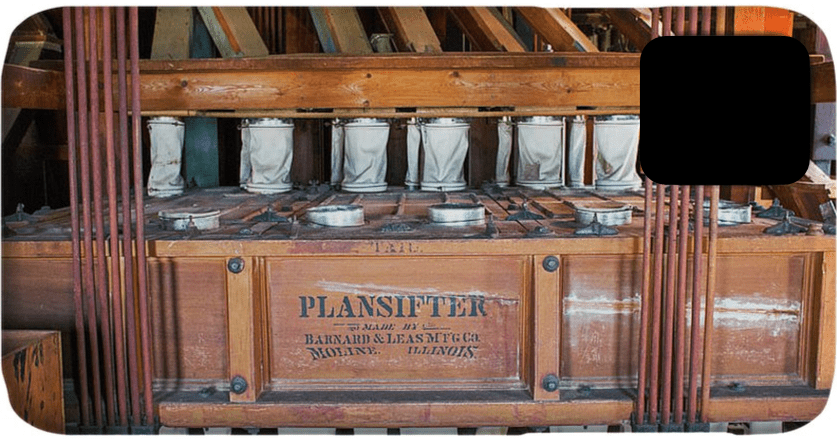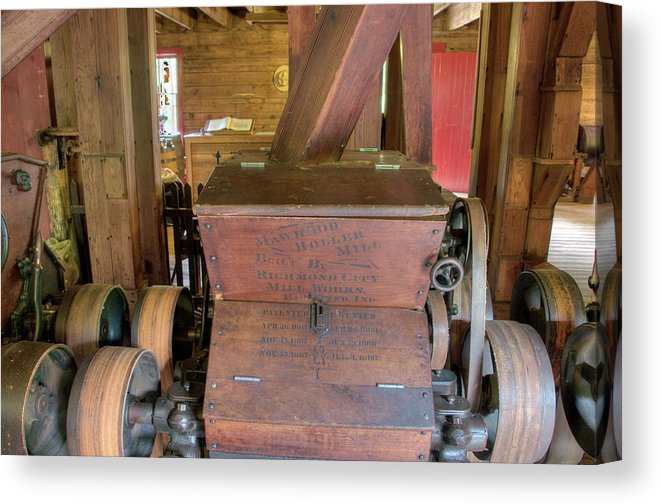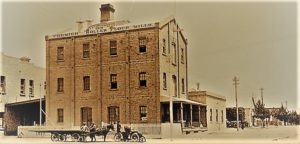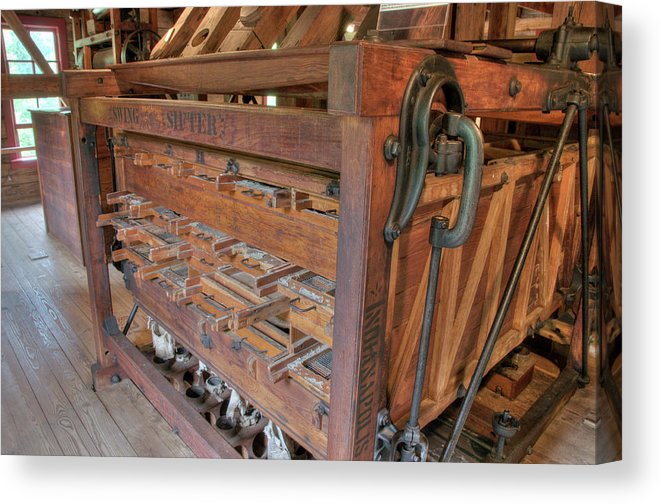Progress of Katanning Flour Mill. Progress of Katanning Flour Mill. Progress of Katanning Flour Mill. Progress of Katanning Flour Mill. Progress of Katanning Flour Mill.
Historic image of the Katanning flour mill.
Picture from State Library of WA
.
Contributed by Alison Underwood;
I have put together some info on the Flour Mills and my great great uncle, Walter Nicholl:
From the Great Southern Herald 26-6 -1918
and the Southern Districts Advocate 26-6-1918
Twenty seven years ago, in 1891, Messrs F. and C. Piesse decided to commence flour milling in Katanning on a small scale and no doubt it was small compared with the extensive plant running today in 1918.
The condition of the town and district at that time did not warrant the erection of a larger mill as little or no wheat was then grown, but as settlers arrived from the other States the country opened up and the amount of wheat grown steadily increased from year to year until the demand for flour was so great that it was found necessary to increase the capacity of the mill to supply all requirements.
The contract, which called for a complete mill to produce two sacks of flour per hour, including building and power plant, was secured by a Melbourne firm of milling engineers. The building was commenced without delay while the machinery was being manufactured in Australia. After running a very short time the capacity was, by the addition of new machinery, increased to five sacks per hour then later to seven sacks. After running for several years it was again increased to ten sacks per hour.
By this time the power driving the mill was beginning to feel the strain placed upon it so the firm installed a new compound tandem engine of great power; also two water tube boilers which carried the reputation of quick steaming, the firm being alive to the fact that should any further increase be made the power would be prepared and able to cope with it.
Shortly the demand for Premier Flour became so great that it was found necessary to again further increase to fifteen sacks per hour. At that time so many mills were being erected throughout State and each one wanted the lion’s share of the trade. Consequently, competition became very keen in milling and Messrs. F. and C. Piesse wisely decided to have the very latest system installed; the Plansifter System being the last word in flour production.

Early “plansifter” for sifting wheat and other cereals before milling into flour similar to that used in the Katanning flour mill.
A complete plant was secured from England which came to hand some two years ago in 1916. Before installing the plansifter system, the firm thought it advisable to secure the services of a first-class mill manager and Mr W.D. Nicholl of New Zealand, was appointed. Mr Nicholl had been in charge for many years of the Timaru Milling Company’s Mill, at Timaru, New Zealand, and was considered by the directors of that Company to be the most successful miller they had ever employed.
Mr Nicholl, who is a native of Scotland, served his apprenticeship at Huntingtower, Perthshire, and comes from an old milling stock. At the age of 22 years he was in charge of the East London Milling Mill in London for a period of six years. Arriving in Melbourne some 30 years ago, round the year 1887, he gained a 1st class Certificate two years later for practical roller milling. He was also highly recommended by the firm of Thos. Robinson and Sons, Manchester, who his father, Henry Simon, represented for many years as milling expert and erector of mills.
He has a very wide experience in up-to-date milling throughout the Commonwealth and his whole ambition is, by careful management and attention to his duties, to supply at all times to the people of Katanning and surrounding districts a flour which will be good and even in quality.
Upon Mr Nicholls’ arrival the mill was once more shut down and the plansifter system installed plus many extensive alterations and additions being made. The pleasing result has been that the mill has been able to turn out 23 sacks per hour and produce a much superior article.

A roller mill similar to that used by the Katanning Roller Flour Mill
Some few weeks ago the mill was again silent to complete the final arrangements and to place in position the new roller mills which came to hand some time ago after the arrival of a swing sifter having been delayed at Singapore on its way from England. This sifter is rather a novelty in machine construction, being suspended from a wood frame by 24 cane rods, the manner whereby it obtains its rotary motion puzzling many who have witnessed its running.
A “Swing Sifter” similar to one that would have been used in the Katanning mill.
In consequence of the extra additions, the capacity of the mill now stands at 28 sacks per hour, with a possible increase to 30 sacks without any more machines. The resulting flour has been proved to be a nice even grade, and of superior quality.
The power end of the plant has been greatly augmented by the introduction of a large condenser which greatly reduces the strain upon the engines and boilers. By condensing the steam that has been going to waste for many years effects a considerable saving in fuel, and the economic working of the whole plant.
The group of grain silos, which are quite a landmark to Katanning and can be seen for many miles, are responsible for the blending of the various wheats so that a uniform sample reaches the mill daily graded and cleaned for grinding.
The present building, as it stands in such a prominent position in Katanning and which has withstood the many alterations and additions, holds within its four walls the most complete system in Australasia. The firm can be congratulated upon having such a complete and up to date plant by means of which flour can be manufactured equal to any in the Commonwealth.

The only known photo of Walter David Nicholl and Emma Auguste Bertha (Nee Hettner), probably taken on their wedding day 23 May 1895.
MARRIAGE
Marriage of Walter David NICHOLL and Emma Auguste Bertha HETTNER by Presbyterian minister William Lang Grierson at house of Matthew Williams, Deverer St, Warnambool, Victoria on 23rd May 1895.
Groom’s birth: Stepney, London, England.
Bride’s birth: Lobethal, South Australia.
West Australian Newspaper
Monday 6 May 1918:
NICHOLL
The Friends of Mr. Walter David Nicholl, head miller of Messrs. F. and C. Piesse Katanning, W.A., are respectfully invited to follow the remains of the late dearly beloved wife, Emma Augusta Bertha, to the place of interment; the Presbyterian portion of the Karrakatta Cemetery. The Funeral is appointed to leave the Private Mortuary of Messrs. Donald J. Chipper and Son, 844 Hay Street Perth, at 10.00 o’clock THIS (Monday) MORNING.
Friends wishing to attend the Funeral may proceed by the 11 o’clock train from Perth.
DONALD J. CHIPPER and SON,
Funeral Directors. 144 Hay Street, Perth.
Telephone A32T2.


